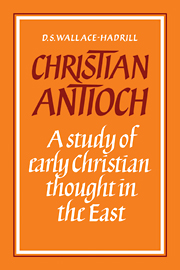Book contents
- Frontmatter
- Contents
- Foreword
- Abbreviations
- Introduction: survey of the history of Antioch
- 1 The religious background to Antiochene Christianity: pagan, Jewish, gnostic
- 2 The interpretation of the biblical record
- 3 Historiography in the Eastern Church
- 4 The doctrine of the nature of God
- 5 The use of Greek philosophy by the Eastern Church
- 6 The human experience of Christ and the salvation of man
- 7 Antiochene theology and the religious life
- Appendix 1 Eastern representation at Nicaea
- Appendix 2 The feminine element in Syrian Christianity
- Notes
- Bibliography
- Index
1 - The religious background to Antiochene Christianity: pagan, Jewish, gnostic
Published online by Cambridge University Press: 03 May 2010
- Frontmatter
- Contents
- Foreword
- Abbreviations
- Introduction: survey of the history of Antioch
- 1 The religious background to Antiochene Christianity: pagan, Jewish, gnostic
- 2 The interpretation of the biblical record
- 3 Historiography in the Eastern Church
- 4 The doctrine of the nature of God
- 5 The use of Greek philosophy by the Eastern Church
- 6 The human experience of Christ and the salvation of man
- 7 Antiochene theology and the religious life
- Appendix 1 Eastern representation at Nicaea
- Appendix 2 The feminine element in Syrian Christianity
- Notes
- Bibliography
- Index
Summary
During the third decade of the first century, the martyrdom of Stephen occasioned the dispersion from Jerusalem of Christians who ‘made their way to Phoenicia, Cyprus, and Antioch, bringing the message to Jews only and to no other. But there were some natives of Cyprus and Cyrene among them, and these, when they arrived at Antioch, began to speak to Gentiles as well, telling them the good news of the Lord Jesus’ (Acts xi.19 f., N.E.B.). Barnabas was sent from Jerusalem and Paul was brought from Tarsus to serve the growing Christian community in the city, and the germination of this early sowing of the Christian seed produced a vigorous growth with its own strongly-marked characteristics. Antiochene Christianity was to become an expression of the faith immediately distinguishable from its neighbours to north and south, bringing Antioch into prolonged conflict with the great ecclesiastical centres of Constantinople and Alexandria.
In seeking to understand the markedly-individual flavour of Antiochene Christianity, we turn first to the soil in which it germinated, pagan and Jewish, and to the gnostic sects which exercised great influence upon all religious activity in Syria during the early years of the Christian era, for it was converts from these three great religious groups who constituted the primitive Antiochene Church. At the time of the foundation of the Antiochene Church in the mid-first century, each of the three was itself developing.
- Type
- Chapter
- Information
- Christian AntiochA Study of Early Christian Thought in the East, pp. 14 - 26Publisher: Cambridge University PressPrint publication year: 1982

